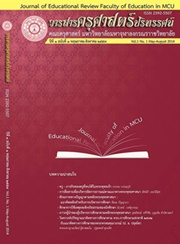The Use of Robes in Theravada Buddhism
Main Article Content
Abstract
This article aims to analyze the use of robes in Theravada Buddhism. The data were collected from the Tipitaka, Commentaries, Sub-commentaries, literary works and related documents. The data were analyzed, classified and presented in a descriptive method. The results of the study found that monks had 3 robes; upper-robe, outer-robe and under-robe. The robe originally referred to discard clothe that the monks collected, cleansed, dyed and sewed in permitted colour and size. Later,the Lord Buddha permitted monks to accept offering-robes called Gahapaticivara. In addition, the permitted robes can be made of bark, cotton, silk, wool, linen and the mixture of five materials mentioned. The use of robes in Theravada Buddhism is focused on the aim of consumption function of robe. That consumption is to fulfill the need in life, not for fun, decoration and social status indication. Monks have to be mindful every time when they put on and off the robes. If they cannot contemplate while wearing the robe, they can make contemplation later. The contemplation on the robe can be done in 3 occasions: while accepting the robe, while wearing the robe and after wearing the robe.
Article Details
ทัศนะและความคิดเห็นที่ปรากฏในบทความในวารสารฉบับนี้ถือเป็นความรับผิดชอบของผู้เขียนบทความนั้นเพียงผู้เดียว และไม่ถือเป็นทัศนะและความรับผิดชอบของกองบรรณาธิการ
กองบรรณาธิการขอสงวนสิทธิ์ในการคัดเลือกบทความลงตีพิมพ์และจะแจ้งให้เจ้าของบทความทราบหลังจากผู้ประเมินบทความตรวจอ่านบทความแล้ว
ต้นฉบับที่ได้รับการตีพิมพ์ในวารสารครุศาสตร์ปริทรรศน์ คณะครุศาสตร์ มหาวิทยาลัยมหาจุฬาลงกรณราชวิทยาลัย ถือเป็นกรรมสิทธิ์ของคณะครุศาสตร์ มหาวิทยาลัยมหาจุฬาลงกรณราชวิทยาลัย ห้ามนำข้อความทั้งหมดหรือบางส่วนไปพิมพ์ซ้ำ เว้นเสียแต่ว่าจะได้รับอนุญาตจากมหาวิทยาลัยฯ เป็นลายลักษณ์อักษร


